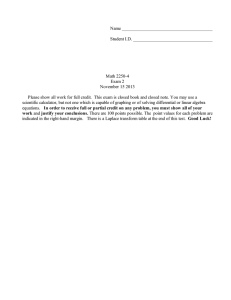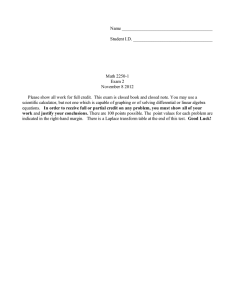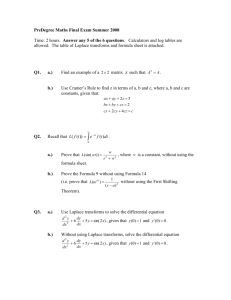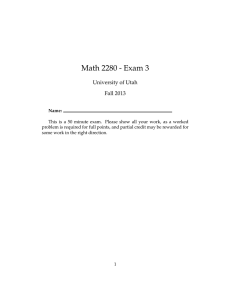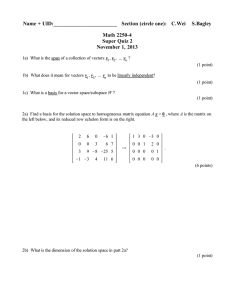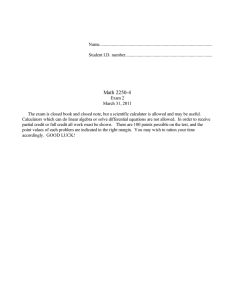L November 15 2013 Math 2250-4
advertisement
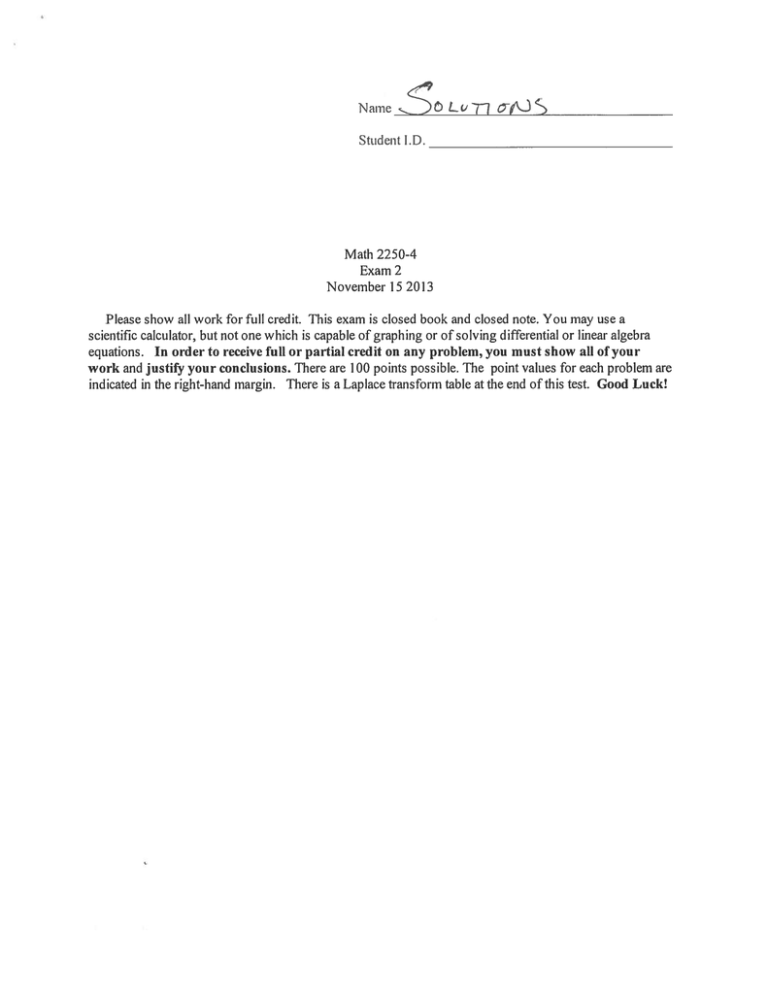
4
Name
L
Student l.D.
Math 2250-4
Exam 2
November 15 2013
Please show all work for full credit. This exam is closed book and closed note. You may use a
scientific calculator, but not one which is capable of graphing or of solving differential or linear algebra
equations. In order to receive full or partial credit on any problem, you must show all of your
work and justify your conclusions. There are 100 points possible. The point values for each problem are
indicated in the right-hand margin. There is a Laplace transform table at the end of this test. Good Luck!
Score
POSSIBLE
20
2
20
3
20
4
15
5
10
6
15
TOTAL
.fl
100
Here is a matrix and its reduced row echelon form:
2 -1
0 3
-3
A
1
1
—1
-2 -3
0
1
101 000
-2
012 02
echelon form of A:
1
2 -4
000 ‘IC)
00000
ig) Find the solution space of vectors x that solve the homogeneous matrix equation A =
explicit solution (with free parameters), in linear combination form.
b4 O
Write your
..
x).. -P
(10 points)
-p—i
2
-
-P
(o,’
1j
t
r
0
‘
irjR
11). Exhibit a basis for the solution space you found in part h.
ro
1-2
\-i
(2 points)
H
)
Define what it means
(2 points)
--
c1
o
ç
-f&{-
&‘t
o
t-.t
c
tJL
(i k
o.
j) Are the vectors
=
-2
]3
=
3
linearly independent or linearly dependent?
2
0
1
Carefully explain why or why not. Hint: these vectors are the first three columns in the matrix A on page
1. The reduced row echelon form result for A from page 1, and reproduced below, may be helpful:
2-1
-3
A
1
0
3
1
-1
-2
0
:=
1-2—3
0
1
1-3’
10100
0 1 2 0 2
reduced row echelon form of A:
2-4-2
00011
00000
(6poiifts)
1
V
1
Vv
-J
vit
S’VL
4
-j
(Ltf\L
-‘
.
Zl
Consider the linear homogeneous differential equation fory(x)
(x) + 4y’ (x) 0.
(x) +
Find a basis of solution functions for this homogeneous differential equation. Hint: use the characteristic
polynomial.
(10 points)
(rn- tr24tFr
6-
4
Se,
2h1
L
-f- +L
‘
Use your work from hand the method of undetermined coefficients to find the general solutiony(x)
to
-
y”(x)+4y”(x)+4y’(x)8x.
(10 points)
4S’t
x (Ax+)
J-
A-
cz)(
2A.
)
p
i3,.
)
)
L(
4-
;i_
(oJ
(4F4f;)
::
z)
qC
/
/
Use Chapter 5 techniques to solve the initial value problem for this forced damped harmonic oscillator
differential equation:
= lOcos(I)
x(O) = 0
x’ (0) = I
You may use the fact that this differential uiai4ilaçsolution
x(t) = 2 cos(t) + sin(t)
i.
(Yoti do not need to check this fact; you cai jt
x’’(t) + 2x’(l) + 5x(1)
.
(12 points)
r2r
r
+
4-
<
t2
R(t1
t
(6
=?
a
-c
C2
f2c
I4242
4’
.
—,
I
[
,()
2t #Sfrlt -2-
j Identify the ‘steady periodic” and “transient’ parts of your so
periodic part in amplitude-phase form. (Express the phase angle cx as an inverse trig function; you don’t
need a decimal value.) Hint: You have enough information to do this problem even if you didn’t solve the
initial value problem in part.
(8 points)
ZLCS&
—2
C- ‘--
(z/)
4
Vt
4
L
4j Re-solve the IVP
from
problem 3,
+2x’(t) +5x(I) = l0cos( 1)
x(O) = 0
x’ (0) = 1
using Laplace transform techniques (and the table at the end of the test). Use the particular solution
x(t) = 2 cos (1) + sin(t) given in problem to deduce two of the four partial fraction coefficients for
X(s). This will save you time in figuring out the other two coefficients (which should also be consistent
with the rest of your solution to 3, but which we would like you tojusti1i algebraically with partial fraction
techniques).
(15 points)
x’’(I)
X(
6-l
4 z
Cs XR)
(
S
x(
h
I
S
As4R
\
.—.—-.
1—
!:2+I
1
sct
(
‘,
—
As
4
—
S
tDs
42s
S
-
)(z
ç)
(Cs)(?i)
(-
s
)ç(c)-z
(
4
4
—
2S
(
4- I
-
...1(s4i)
‘)
,—I----
‘:
4-
“-Z
-4
CM
C
-C
H
0
lu’
‘J\
V
-t
11
‘d’.
i\
UN
C
I-,
‘-3
t
-t-
)
CM
vi Go
It
C
-“N
II
+
CD
CD
-4
C
C)
CM
C
C)
CD
CD
-J
CD
C
CM
C
CD
-4
CD
CD
CD
C
CD
CD
-J
CM
1
C)
C)
2IE
6) A focus in this course is a careful analysis of the mathematics and physical phenomena exhibited in
forced and unforced mechanical (or electrical) oscillation problems. Using the mass-spring model, we’ve
studied the differential equation for functions x(1) solving
0 cos(wt)
mx’’ + cx’ + kx=F
with in, k, co > 0; c
0.
0
0, F
, co represent in this model. Also give their units
0
6a) Explain what each of the letters in, k, c, F
in the inks
system.
(10 points)
.
0
AD
a.
/
N
(/)
c-
0 > 0) that we’ve studied in this class that is
6b)cçbe one of the two forced oscillation phenomena (F
ntsbnance. Use the correct terminology for this phenomenon. Explain what parameter values
co, c lead to this phenomenon. Indicate which part of the solution formula reflects this phenomenon.
(You don’t need to exhibit the precise solution formula, just the form it takes.)
(5 points)
,J
Lö CC) --s
&v’&
o
cL
‘
1(
&
v-c
(X
S
i
a
0
fr_
({A
TaNe of Laplace Transforms
Laplace transforms of panicuiar funcrions
This table swumarizes the general properties of Laplace transforms and the
derived in Chapter 10.
.———-—
i—..
Transform
Function
-;f
TransIorm
Function
F(s)
af(t) + bg()
oF(s) ± bG(s)
f’Q)
sF(s)—f(0)
(s
—
.5
(s)
.c
F
2
—
sF(s)
sf(O)
—
s’f(0)
—
—
k
sink!
f’(O)
+k
2
s
S
f( 0(0)
coshkt
F(s)
f(r)dr
j0
—
coskt
—k
2
s
k
—k
2
s
sinhici
S
—
F(s
e”f(r)
—
f
a)f(r —a)
—
s—a
2
2+k
a)
e’ coski
a)
—
k
e” sinki
eF(s)
(s
k!coskt)
F(s)G(.s)
—.j(sinkI
if(s)
—F’(s)
sinki
tf(i)
(—1 )F(s)
(sin ki + ki coskt)
L2
f
u(t —a)
f(r)g(r
—
r) d-r
f
F(u)dcr
(p
f(s). period p
e
‘
1
f
e”f(i)d!
—
-
—
+k
2
a)
)
2
+k
+k
(s
2
)
)
2
2+k
(s
S
e
a)
(1)tt/a]
—
(square wave)
-tanh
S
IF!1
Lou
11!
1”
F(a + 1)
s+
(staircase)
s(I
—
